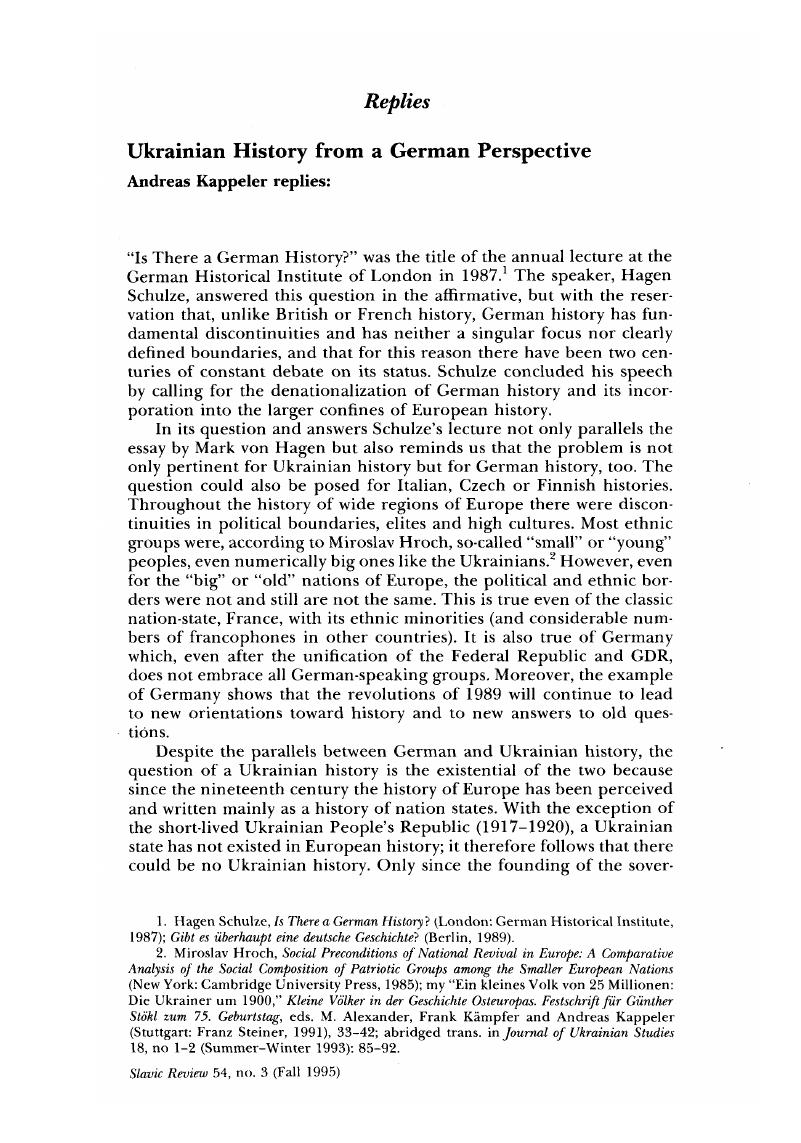Published online by Cambridge University Press: 27 January 2017

1. Schulzes, Hagen There a German History (London: German Historical Institute, 1987 Google Scholar; Gibt es überhaupt eine deutsche Geschichte (Berlin, 1989).
2. Hroch, Miroslav, Social Preconditions of National Revival in Europe: A Comparative Analysis of the Social Composition of Patriotic Groups among the Smaller European Nations (New York: Cambridge University Press, 1985 Google Scholar; my “Ein kleines Volk von 25 Millionen: Die Ukrainer um 1900,” Kleine Völker in der Geschichte Osteuropas. Festschrift für Günther Stökl zum 75. Geburtstag, eds. M. Alexander, Frank Kampfer and Andreas Kappeler (Stuttgart: Franz Steiner, 1991), 33–42; abridged trans, in Journal of Ukrainian Studies 18, no 1–2 (Summer-Winter 1993): 85–92.
3. The concept of eastern European history as a special field of historical studies in Germany includes not only middle eastern Europe and southeast Europe, but also Russia. See Klaus Zernack, Osteuropa: Eine Einführung in seine Geschichte (Munich: C.H. Beck, 1977).
4. Stokl, Günther, Osteuropa—Geschichte undPolitik (Opladen: Westdeutscher, 1979), 16.CrossRefGoogle Scholar
5. For a history of the field of eastern European history in Germany, see Voigt, Gerd, Rufiland in der deutschen Geschichtsschreibung (Berlin: Akademie, 1994 Google Scholar; Camphausen, Gabriele, Die wissenschaftliche historische Rufilandforschung im Dritten Reich 1933–1945 (Frankfurt: Peter Lang, 1990 Google Scholar; Zernack, Klaus, “Bemerkungen zur Geschichte und gegenwärtigen Lage der Osteuropahistorie in Deutschland,” Europa Slavica—Europa Orientalis, Festschrift für Herbert Ludat zum 70. Geburtstag, eds. Grothusen, Klaus Detlev and Zernack, Klaus (Berlin: Duncker & Humblot, 1980), 542–59Google Scholar; Burleigh, Michael, Germany Turns Eastwards: A Study of Ostforschung in the Third Reich (New York: Cambridge University Press, 1988 Google Scholar.
6. Doroschenko, Dmytro, Die Ukraine und das Reich: Neun Jahrhunderte deutsch-ukrainischer Beziehungen im Spiegel der deutschen Wissenschaft und Literatur (Leipzig: S. Hirzel, 1941)Google Scholar, reprint Munich 1994; Zhukovsky, A, “Germany,” Encyclopedia of Ukraine (Toronto: University of Toronto Press, 1988), 2: 47–56 Google Scholar; Mark, Rudolf A.: “Johann Christian von Engel (1770–1814) als Historiograph der Ukraine,” Zeitschrift fur Ostforschung 36 (1987): 191–201.Google Scholar
7. See the literature cited in notes 5 and 6, and also Peter Borowsky, “Paul Rohrbach und die Ukraine: Ein Beitrag zum Kontinuitätsproblem,” Deutschland in der Weltpolitik des 19. und 20. Jahrhunderts. Fritz Fischer zum 65. Geburtstag, eds. I. Geiss and B.J. Wendt (Düsseldorf: Bertelsmann, 1973), 437–62.
8. Dallin, Alexander, German Rule in Russia 1941–1945: A Study of Occupation Policies (New York: St. Martin's Press, 1957)Google Scholar; Pol, Diter, “Fashystska okupatsiia Ukra'iny v 1941–1944. rr. u pratsiakh zakhidnykh uchenykh,” Ukrainskyi istorychnyi zhurnal 5 (1994): 127–36.Google Scholar
9. Stökl, Günther, “Hans Koch 1894–1959,” Jahrbücher für Geschichte Osteuropas 7 (1959): 117–29.Google Scholar
10. Carsten Kumke, “Das Ukrainische Wissenschaftliche Institut in Berlin: Ein Institut zwischen Politik und Wissenschaft,” Jahrbücher für Geschichte Osteuropas 43 (1995), in print. One of the protectors of the institute was General Wilhelm Groener. In 1918 he was a leader of German Ukrainian politics; during the Weimar Republic he was minister of the interior and chief of defense.
11. Stökl, Günther, Die Entstehung des Kosakentums (Munich: Isar, 1953 Google Scholar; Heyer, Friedrich, Die orthodoxe Kirche in der Ukraine von 1917 bis 1945 (Cologne, 1953)Google Scholar; Geyer, Dietrich, “Die Ukraine im Jahre 1917: Russische Revolution und nationale Bewegung,” Geschichte in Wissenschaft und Unterricht 8 (1957): 670–87.Google Scholar
12. This trend was first noticeable at the international conference on the history of German-Ukrainian relationships in Garmisch in 1986. Most of the lectures were published in German-Ukrainian Relations in Historical Perspective, eds. Hans-Joachim Torke and John-Paul Himka (Edmonton: Canadian Institute of Ukrainian Studies, 1994).
13. Among these dissertations are excellent works, like Carsten Kumke, Führer und Geführte bei den Zaporoger Kosaken: Struktur und Geschichte kosakischer Verbände im polnisch-litauischen Grenzland (1550–1648) (Berlin: Harrassowitz, 1993), Forschungen zur Osteuropäischen Geschichte (herafter FOG) 49; Ernst Lüdemann, “Zur Lösung der Nationalen Frage in der sowjetukrainischen Geschichtsschreibung,” FOG 40 (1988), 229–395; Mark, Rudolf A., “Symon Petljura und die UNR: Vom Sturz des Hetmans Skoropads'kyj bis zum Exil in Polen,” FOG 40 (1988), 7–228 Google Scholar; Neutatz, Dietmar, Die “deutsche Frage” im Schwarzmeergebiet, und in Wolhynien: Politik, Wirtschaft undAlltag im Spannungsfeld von Nationalismus und Modernisierung (1856–1914) (Stuttgart: Steiner, 1993.Google Scholar
14. Velychenko, Stephen, Identity in Eastern Europe and Russia: Soviet-Russian and Polish Accounts of Ukrainian History, 1914–1991 (New York: St. Martin's Press, 1993).CrossRefGoogle Scholar
15. From a Polish perspective, the work of Daniel Beauvois gives new insight into the social history of Ukraine (Le noble, le serf et le revizor: La noblesse polonaise entre le tsarisme et les masses ukrainiennes 1831–1863 (Paris: Archives contemporaines, 1985); La bataille de la terre en Ukraine 1863–1914: Les Polonais et les conflits socioethniques (Lille: Presses Universitaires, 1993).
16. Potichnyj, Peter J. and Aster, Howard, eds. Ukrainian-Jewish Relations in Historical Perspective (Edmonton: Canadian Institute of Ukrainian Studies, 1988)Google Scholar.
17. Stebelsky, Ihor, “Ukrainian Peasant Colonization East of the Urals, 1896–1914,” Soviet Geography 25 (1984): 681–94.Google Scholar
18. See Subtelny, Orest, “Die gegenwärtige Situation der ukrainischen Historiographie: Ein Überblick,” Ukraine: Gegenwart und Geschichte eines neuen Staates, eds. Hausmann, Guido and Kappeler, Andreas (Baden-Baden: Nomos, 1993) 350–69.Google Scholar
19. Exceptions are Edelman, Robert, Proletarian Peasants: The Revolution of 1905 in Russia's Southwest (Ithaca: Cornell University Press, 1987 Google Scholar; Himka, John-Paul, Galician Villagers and the Ukrainian National Movement in the Nineteenth Century (New York: Macmillan, 1988 CrossRefGoogle Scholar; Hryniuk, Stella, Peasants with Promise: Ukrainians in Southeastern Galicia, 1880–1900 (Edmonton: Canadian Institute of Ukrainian Studies, 1992)Google Scholar; Worobec, Christine, “Temptress or Virgin?: The Precarious Sexual Position of Women in Postemancipation Ukrainian Peasant Society,” Slavic Review 49 (1990): 227–38.CrossRefGoogle Scholar
20. See, as one of the few examples, Subtelny, Orest, Domination of Eastern Europe: Native Nobilities and Foreign Absolutism, 1500–1715 (Kingston: McGill-Queen's University Press, 1986).CrossRefGoogle Scholar
21. For a comparison of the Ukrainian national movement in the Russian Empire and other national movements in Europe, see Andreas Kappeler, ed., with Fikret Adanir and Alan O'Day, The Formation of National Elites, vol. 6, Comparative Studies on Governments and Non-Dominant Ethnic Groups in Europe, 1850–1940 (New York: New York University Press, 1992).